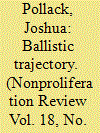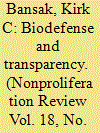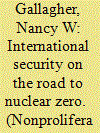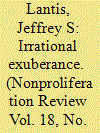| Srl | Item |
| 1 |
ID:
105205


|
|
|
| 2 |
ID:
105207


|
|
|
| 3 |
ID:
105204


|
|
|
|
|
| Publication |
2011.
|
| Summary/Abstract |
This article assesses, via analysis of two case studies, the relationship between the dual-use nature of biological research and negative perceptions of the US biodefense program. The primary case study is the controversy over the National Emerging Infectious Diseases Laboratories, an as-yet-unopened maximum-containment biodefense facility in Boston that some locals suspect will be used for illegal offensive biological weapons (BW) work. Lessons from this controversy are considered in the international context via a second case study: the Cold War-era Soviet bioweapons program, which was continued in part due to the Soviet belief that the US biodefense program was really a cover for offensive BW work. The two case studies demonstrate that misperceptions of US biodefense can have serious consequences that may threaten US national security. Underlying such misperceptions is the unavoidable dilemma of dual-use-legitimate peaceful research and technologies can overlap with offensive military activities. Politics play a critical role in determining outsiders' interpretations of the intent of US biodefense activities, transforming the dual-use dilemma from a descriptive concept into a problem in which misperceptions can be highly damaging. Taking into account the important role of political relations, the article argues that negative perceptions of the US biodefense program should not be simply accepted as a fait accompli, intrinsic to the dual-use nature of the life sciences, but rather that they can and should be addressed. The article identifies greater transparency measures as crucial to doing this.
|
|
|
|
|
|
|
|
|
|
|
|
|
|
|
|
| 4 |
ID:
105209


|
|
|
| 5 |
ID:
105208


|
|
|
| 6 |
ID:
105206


|
|
|
| 7 |
ID:
105203


|
|
|
|
|
| Publication |
2011.
|
| Summary/Abstract |
Between the 1960s and the 1990s, the US chemical industry went from lobbying against the Geneva Protocol and promoting increased funding for chemical warfare to refusing to produce binary chemical weapons and assisting with the negotiations of the Chemical Weapons Convention (CWC)-even though the treaty included provisions that could be costly to industry. What happened in those thirty years to make the US chemical industry reverse its position on chemical weapons? This article argues these changes were largely caused by the chemical industry's desire to reform the negative public image it had acquired due to its involvement in the Agent Orange scandal and other high-profile incidents during the 1970s and 1980s. The chemical industry's assistance with CWC negotiations may be explained after an examination of the US public policy literature, which argues that industry will support apparently costly regulations if doing so helps it repair a damaged public image and ensures greater profits in the long run.
|
|
|
|
|
|
|
|
|
|
|
|
|
|
|
|